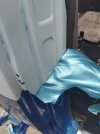Usually base or clear can base or clear can easily be peeled sometime in the first week if broken because of the amount of solvents still left.
So it's a solvent issue that's not escaped.
Some bases dry faster than others, and silver over black- coverage? The number of coats?
Reducer used and speed vs. temp?
The activator's speed in clear can slow the evaporation down, such as a medium speed or fast, and it's 85 or higher out.
To go faster, you go slower, so true.
The test when a spot breaks from bolting to tight in a spot is:
Leave it overnight, and the next day test it with a thumbnail, and you will have adhesion as solvents will rush out of the broken area.
Edit.
Another question is how long the epoxy was on before basing?

